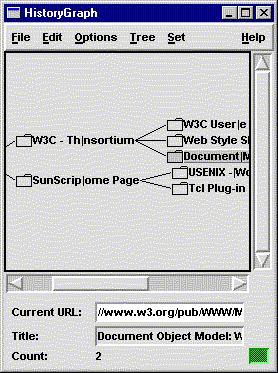|
| |||||||||||||||||||||||||||||||||||||||||||||||||||

| ||||||||||||||||||||||||||||||||||||||||||||||||||||
Fifth Annual Tcl/Tk Workshop, 1997
[Technical Program]
Abstract
This poster describes the
design and implementation of a Web history tool that automatically
tracks user browsing activities, presents a graphic visualization
of this activity, and provides a mechanism for manipulation and
use of the history. This tool, called HistoryGraph, demonstrates
the power of using Tcl and Tk, especially through the reuse of
existing components to create a powerful application in a short
time. Our goal was to create a browser independent tool which automatically creates a browsing history, making it easy to record sites visited, easy to return to sites, and possible to create trails to share with others. Unlike bookmarks, this history is displayed graphically, is directly manipulatable and may be integrated with other tools which work with URLs.
HistoryGraph
automatically records the URLs and titles of sites visited, and builds
a tree representation of the browsing history (See Figure 1).

The user may reorganize this tree using drag and drop, and revisit
sites by clicking on them in the tree. They may create sets of
sites by selecting sites using pattern matches on the URLs or
titles. Sets may be passed to other applications which may also
add sites to the tree. The use of HistoryGraph is described
in detail elsewhere [Hirsch97].
We decided to implement HistoryGraph
using Tcl/Tk in order to take advantage of the Tk graphical user
interface toolkit, the rapid prototyping environment offered by
Tcl/Tk, and the ease of integration with other web applications
we had written in Tcl. Our group had attempted previous implementations
of HistoryGraph using C and user interface libraries but
these approaches had taken too long and were too difficult to
modify. Using Tcl/Tk we were able to get a basic prototype operating
in two months. Tcl/Tk also allowed us to perform incremental development,
such as first creating a basic browsing history, then adding the
ability to create and manipulate sets, and finally integrating
HistoryGraph with other applications.
Implementation of HistoryGraph
required more than Tcl/Tk code. We had to build special code for
the NT platform, incorporate a tree drawing widget, and implement
browser interfaces. Although Tcl/Tk is a portable interpreted
language, we had to build an interpreter for Windows NT, and used
the tknt40r1 package to do this. In order to build an intuitive user interface, showing a graphical representation of sites visited, we used an existing tree widget. This tree widget was built in C++ and required building a special wish to incorporate it.
To make a browser-independent
tool, we needed two application programming interfaces from browsers:
Not all browsers support these
interfaces, but those which fully support the Spyglass Software
Development Interface [SDI] do. Netscape Navigator 3.02
supports
this on Windows NT using the Dynamic Data Exchange (DDE) implementation
[Netscape-DDE];
Mosaic supports it on Unix using the NCSA Common Client Interface
(CCI).
An alternative to using a
browser interface is to intercept the HTTP stream between the
browser and server, and capture URL and document information from
the stream. This approach may become confusing to the user because
the browser cache and "back" button may prevent all
information from being transmitted over the network. This approach
also requires the user to proxy their browser, and may not work
with encrypted streams. We decided that close integration is
best.
We integrated the HistoryGraph
with other applications written in Tcl/Tk by using "send",
and by later implementing a notification facility
[Meeks].
One
such application is designed to determine which pages have or have not
changed since a specified time (WhatsNew) and the other is used to return the
pages which are linked to by the page (LinkTree). Using Tcl/Tk
allowed us to integrate these standalone
applications in less than a week, substantially increasing the
power of HistoryGraph through the reuse of existing applications.
Installation was an issue
which made it difficult for users to use the system. Using HistoryGraph
requires installing a special version of Tcl/Tk on their machine,
installing HistoryGraph, and remembering to run this application
when browsing. This is too cumbersome for everyday use. We would
like to find an alternative implementation which would simplify
installation and use. We are considering using the Tcl/Tk plugin
which could simplify installation while allowing us to use the
latest version of Tcl/Tk. This approach would require the use
of shared libraries for custom functionality such as DDE support.
Our primary concern is the
lack of a portable browser application programming interface which
will continue to be supported. The only interface which supports
installation of a callback for notification of page changes is
DDE on NT with Netscape Navigator, or CCI on Unix with Mosaic.
We have not discovered a way to implement this functionality using
OLE, plugins, JavaScript or with Java Applets. General support
for the Spyglass Software Development Interface is lacking, and
full support for the DDE implementation is limited. Without such
an interface, the techniques we used for HistoryGraph will
be impossible to implement. What is needed is an portable application
interface supporting tight integration of applications with browsers.
Such a portable and supported interface would open the door to
many interesting applications involving browsers. We need full
support for an interface such as the Spyglass Software Development
Interface, ideally from plugins.
A demonstration version of
the original HistoryGraph software is available at
https://www.osf.org/www/waiba/webwarev2_1/.
Acknowledgments
This research was supported
in part by the Defense Advanced Research Projects Agency (DARPA)
under the contract number F19628-95-C-0042. The views and conclusion
contained in this document are those of the author and should
not be interpreted as representing the official policies, either
expressed or implied, of the Defense Advanced Research Projects
Agency or the U.S. Government.
My thanks go to Charles Brooks
and Scott Meeks for their contributions to this project.
References
|
|
This paper was originally published in the
Proceedings of the Fifth Annual Tcl/Tk Workshop 1997,
July 14-17, 1997,
Boston, Massachusetts, USA
Last changed: 16 April 2002 aw |
|